Introduction to Tarachain
This white paper is a newly published white paper that has been structurally and technologically upgraded from 'TARA COIN' to 'TARA CHAIN'.
Please refer to the previously released TARACOIN white paper, ‘Taracoin - White Paper’.
TARA CAIN
TARA CHAIN was launched with the purpose of commercializing blockchain by applying it to the real economy by closely approaching the market as well as connecting smart contracts, communities, and blocks.
Looking back at human history, the development of technology has not only changed human life but also influenced human values. In particular, as we entered the digital age, the explosive growth of various social media from the emergence of virtual worlds and immersive experiences has established internet as an ‘exist anytime, anywhere medium’ for communication and commerce.
The Internet and digital technologies that have developed in this way seem to satisfy human needs for personalization, but in reality, they are becoming more and more centralized. And with the advent of blockchain technology, digital technologies, including the Internet, are about to undergo a major transformation not only online but also in real life.
In this situation, TARA CHAIN can be seen as a research and attempt to present a new paradigm for the digital age from a connection between reality and virtuality, perspectives of real life and humanities.
Vision of TARA CHAIN
The TARA CHAIN Project was started with the purpose of commercializing blockchain by applying it to the real economy by closely approaching the market as well as connecting smart contracts and blocks. This can be seen as a research and attempt to present a new paradigm for the digital age from a connection between reality and virtuality, perspectives of real life and humanities.
Background of TARA CHAIN
TARA CHAIN was launched with the purpose of commercializing blockchain by applying it to the real economy by closely approaching the market as well as connecting smart contracts, communities, and blocks.
Looking back at human history, the development of technology has not only changed human life but also influenced human values. In particular, as we entered the digital age, the explosive growth of various social media from the emergence of virtual worlds and immersive experiences has established internet as an ‘exist anytime, anywhere medium’ for communication and commerce.
The Internet and digital technologies that have developed in this way seem to satisfy human needs for personalization, but in reality, they are becoming more and more centralized. And with the advent of blockchain technology, digital technologies, including the Internet, are about to undergo a major transformation not only online but also in real life.
In this situation, TARA CHAIN can be seen as a research and attempt to present a new paradigm for the digital age from a connection between reality and virtuality, perspectives of real life and humanities.
TARA CHAIN connects each community through smart contracts. Based on the TARA CHAIN network, anyone can freely create a blockchain project and even build a new network.
Just as a forest starts from a single tree, a new ecosystem is created within the ecosystem called TARA CHAIN, and it organically interconnects and expands. In order to realize our vision, we defined the components and types of the network and studied methods and governance for proper operation of the components.
Structure of TARA CHAIN
Consensus algorithm
Consensus mechanism
Blockchain networks do not judge the validity of blocks and transactions on a central server. Therefore, participants must independently verify that there are no problems with the information delivered and judge its validity. In addition, in a fully decentralized P2P network, problems may occur in the information transmission process due to reasons such as network delay, duplicate reception, and intentional tampering. Therefore, the following problems must be resolved through a consensus mechanism, and specific nodes must be prevented from arbitrarily manipulating the blockchain. Therefore, a method is needed to verify the validity of blocks and transactions. When linking blocks to a chain, if there are more than one valid blockchain at the same time, there must be a rule to choose between them.
PoW(Proof-of-Work)
Proof-of-Work (PoW) is the process of finding a hash value to create a block at a certain level of difficulty and then proving it. In Proof-of-Work (PoW), individual nodes can create blocks without restrictions. Therefore, a fork (or collision) phenomenon may occur where two or more blocks are attached to the previous block. This phenomenon means that the distributed ledger function did not work properly. Therefore, we are solving the inconsistency problem by selecting longer blocks where more Proof-of-Work (PoW) has been performed.
Process of Proof-of-Work
Proof-of-work, also known as mining, is an algorithm that proves participation in the work by repeating the process of finding the nonce value countless times, and the participant in the proof-of-work is called a 'miner'. Simply put, proof-of-work is an algorithm that grants permission to create blocks to those who quickly solve difficult problems and provides coins as a reward.
The step-by-step mechanism of proof-of-work is as follows.
1. Newly occurring transactions are grouped together in units called blocks.
2. Miners try to be the first to solve complex computational tasks in order to propose the creation of a new block.
3. One miner who finds the nonce value is selected. Miners receive newly minted cryptocurrency as a reward from the network and add new blocks to the blockchain.
Compensating for the shortcomings of PoW (Proof-of-Work)
As mining difficulty increases, the Proof-of-Work (PoW) method requires more high-end equipment for computation, and energy waste increases due to excessive power consumption. As mining difficulty increases, it becomes difficult for individual miners to continuously maintain hash power, and the number of professional enterprise-level miners increases. As this happens, unity among mining operators can occur, which can lead to a situation where the foundation of the consensus mechanism is destroyed.
Core node in private
TARA CHAIN's consensus node operates in a private manner, preventing the indiscriminate proliferation of nodes and complementing the shortcomings of general PoW (Proof-of-Work). This prevents power consumption due to excessive competition and prevents the essence of blockchain technology from being obscured by specific interest groups.
Accounts
It is made up of objects called “accounts” in TARA CHAIN, and each account contains a 20-byte sized address and state transitions that represent direct transactions of value and information between accounts. TARA CHAIN account has the following 4 properties.
· nonce: Counter to ensure that each transaction is processed only once
· value: Current TARA balance in your account
· contract code: Contract code for your account (may have no value)
· storage: Storage of the account (empty by default)
EOA(Externally Owned Accounts) and CA(Contract Account)
Accounts are largely divided into EOA (Externally Owned Accounts), which are general accounts, and CA (Contract Accounts), which are accounts assigned to contracts.
EOA is a type of general user account that has a private key that controls the address of the account, allowing transactions to be signed and executed. Therefore, you can transfer assets owned by the account to another EOA or CA or call a smart contract.
All accounts that we manage through wallet applications such as MetaMask to hold assets such as cryptocurrency or NFT are EOA.
CA is an account assigned when deploying smart contracts on the blockchain, and is used to distinguish specific smart contracts. Because the CA does not have a separate private key, it cannot sign and issue transactions on its own, and it can only receive data through transactions issued by other EOAs or calls from the execution of other contracts and execute the embedded fixed code on-chain.
In TARA CHAIN, a contract is not something that needs to be executed or compiled, but rather an autonomous agent that lives within the execution environment of TARA CHAIN, always executing specific code when a message or transaction arrives. Also, a contract directly controls your key/value store to track your Tara balance and persistent variables. This concept is called a smart contract.
TARA CHAIN generates asymmetric encryption keys using elliptic curve cryptography (=ECC) with various parameters. Parameters are used to adjust speed and security, and TARA CHAIN uses secp256k1. TARA CHAIN's private and public keys are 256-bit numbers, and all accounts are expressed as addresses.
TARA CHAIN Block
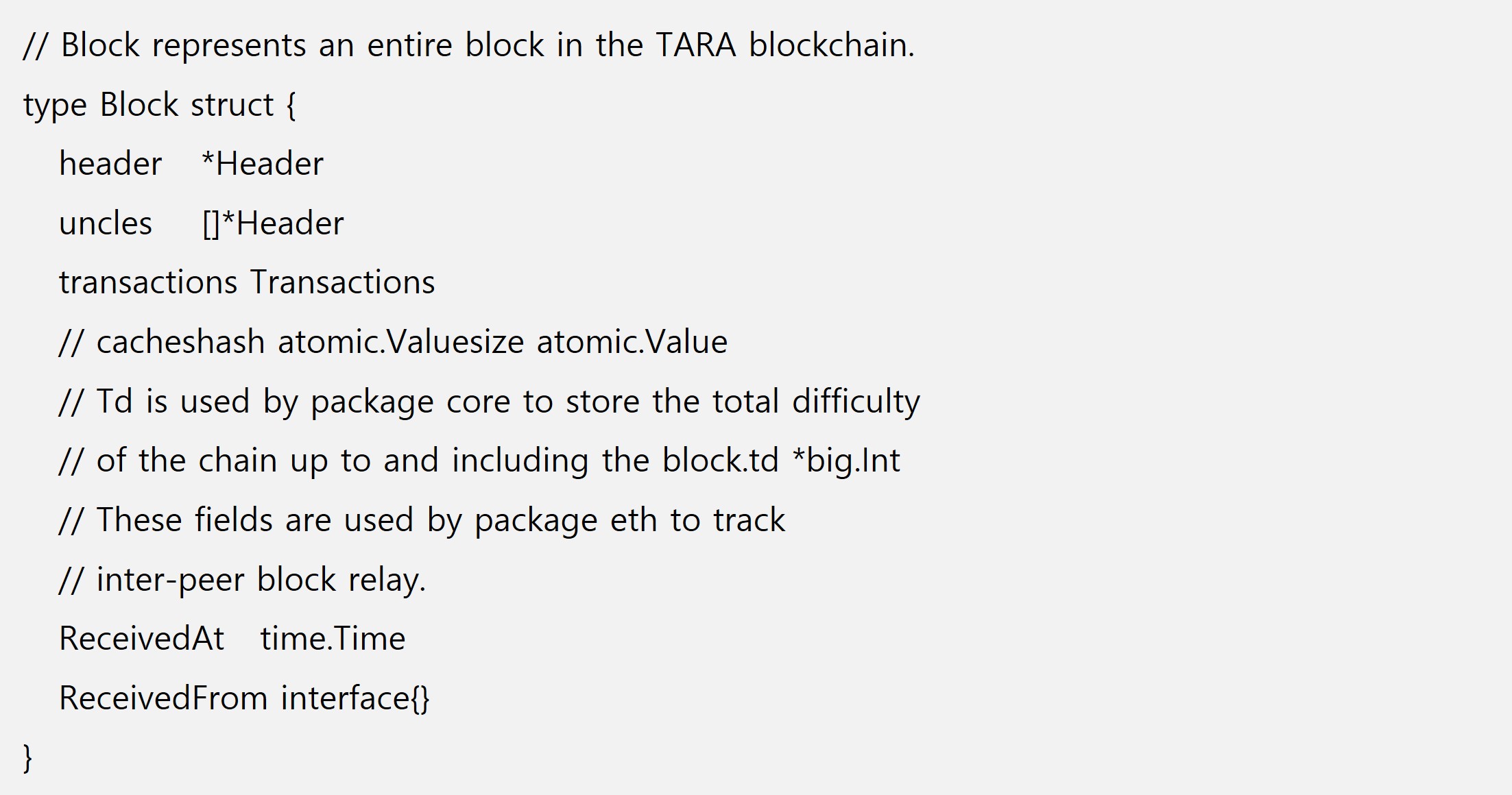 TARA CHAIN Block Header
TARA CHAIN Block Header
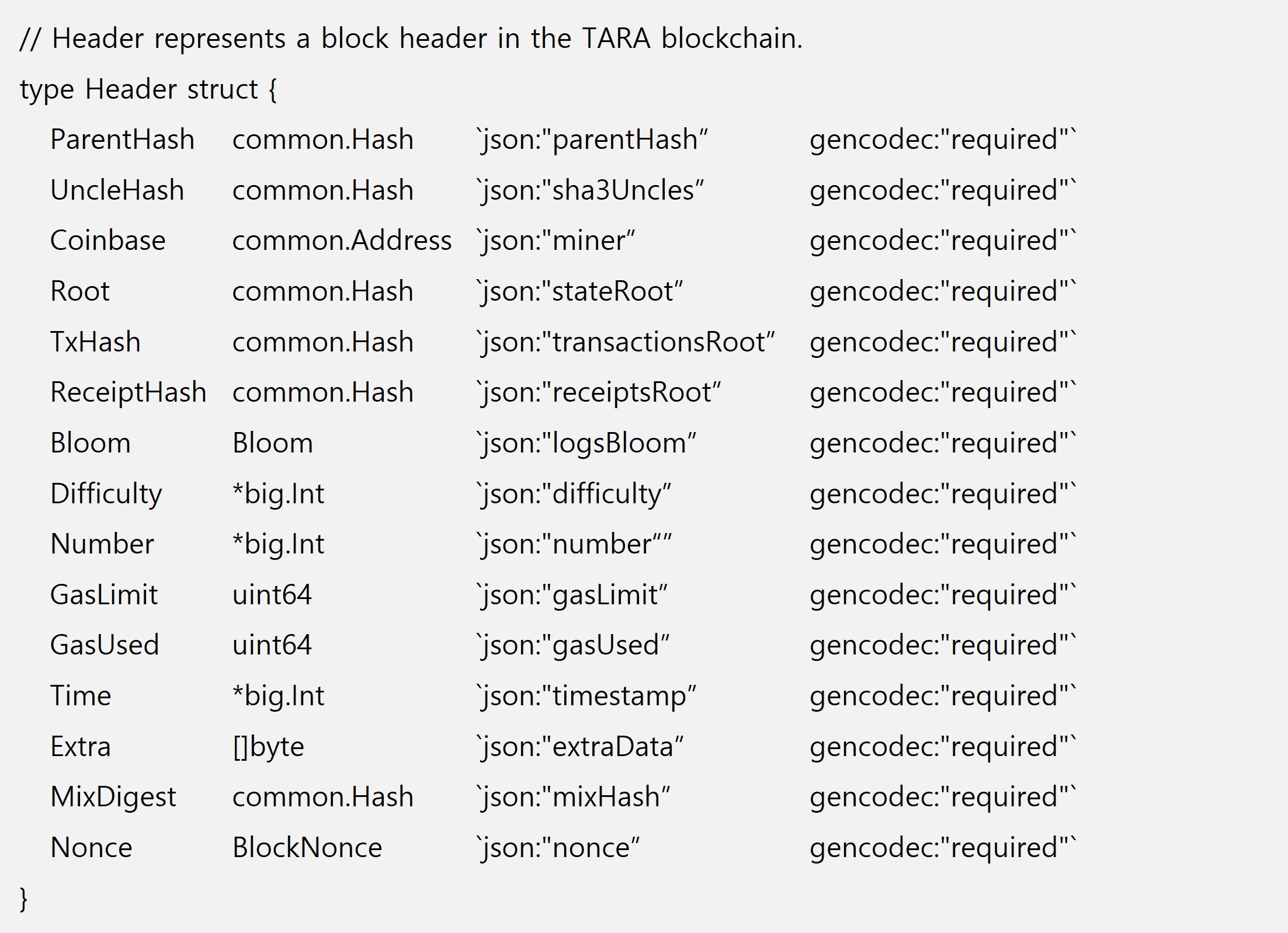
ParentHash : Hash value of parent block
UncleHash : Hash values of the Uncle blocks of the current block
Coinbase : Account address that will receive the fee for the transaction after mining
Root : The root node hash value of the Merkle Patricia tree that contains account status information
TxHash : Merkle tree root node hash value for all transactions in a block
ReceiptHash : Root node hash value of the Merkle tree of receipts for all transactions in the block
Bloom : 32-byte bloom filter used to access log information
Difficulty : Block difficulty is calculated from the difficulty and timestamp of the previous block
Number : Current block number
GasLimit : Maximum total amount of gas payable per block
GasUsed : Total amount of gas used for transactions within a block
Time : First creation time of block
Extra : Other information about the block
MixDigest, Nonce : A value used to ensure a sufficient number of calculations calculating the hash value in proof-of-work
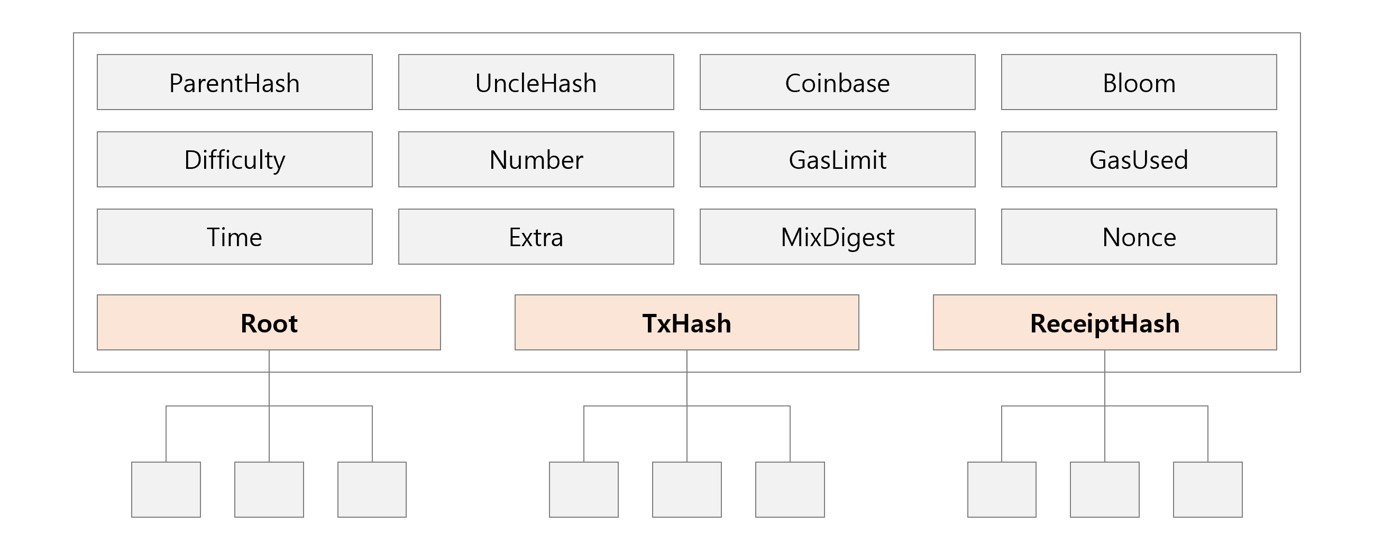
Root, TxHash, and ReceiptHash correspond to the final root hash value obtained by hashing each node of the Merkle tree, and the remaining values can each be viewed as a constant.
TARA CHAIN Blockchain and Mining
Unlike 'Bitcoin', which only stores transaction information in blocks, Tarachain's blockchain contains not only the transaction list but also the most recent status, and also stores two other values, block number and difficulty, in the block. The basic Tarachain block verification algorithm is as follows:
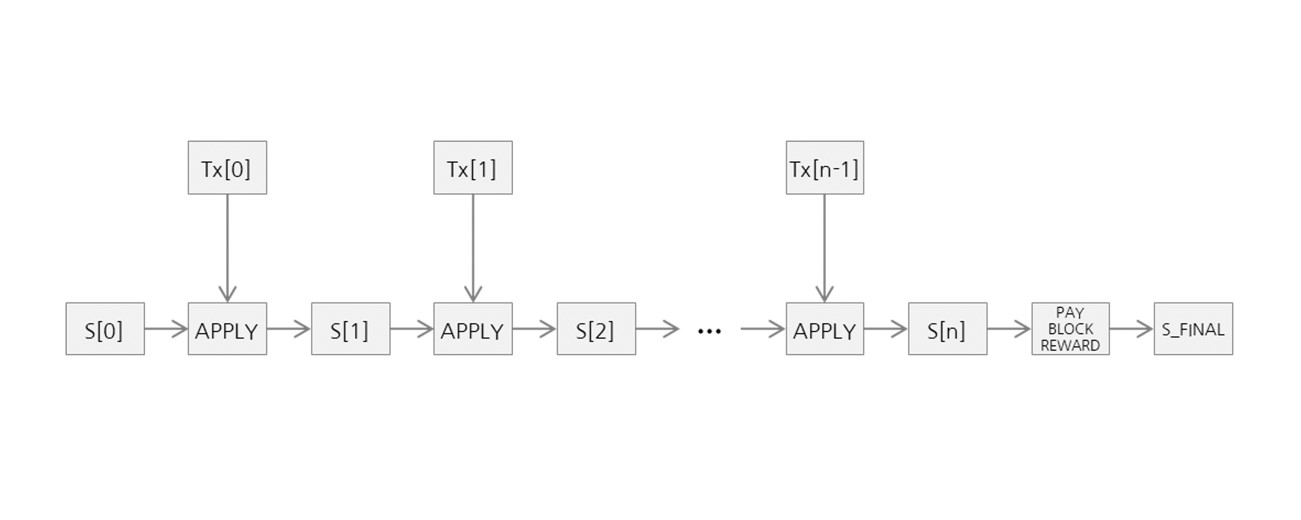
1. Check if the referenced previous block exists and is valid.
2. Check whether the timestamp of the block is later than the timestamp of the previous block and is within 15 minutes after that.
3. Check if the block number, difficulty, transaction route, uncle route, and gas limit are valid.
4. Check whether the proof-of-work of the block is valid.
5. Assume that S[0] in the figure above is the state at the end of the previous block.
6. Assume that for all i in 0...n-1, set S[i+1] = APPLY(S[i],TX[i]), TX is the transaction list of the bloc the transaction . An error is returned when any application returns an error, or the amount of gas consumes exceeds GASLIMIT.
7. After adding S[n] to the reward block paid to the miner, assume this is S_FINAL.
8. Check whether the state of the Merkle tree root of S_FINAL matches the final state stored in the block header. If they match, the block is valid. But if not, the block is invalid.
The process of executing the contract code is part of the state transition function definition, which is part of the block verification algorithm. So that when a transaction is included in block B, the execution of the code caused by that transaction will occur on all nodes that download and verify block B.
Staking
Staking is the act of depositing TARA to activate the validator software. Validators are responsible for storing data, processing transactions, and adding new blocks to the blockchain. This will help keep TARA CHAIN safe for everyone and earn new TARA in the process.

'Get Rewards’
Rewards are given for actions that help the network reach consensus. You are rewarded for running software that properly places transactions into new blocks and verifies the work of other validators. This will allow the chain to continue to run safely.

'Better Security’
The network becomes more resistant to external attacks as more TARA is staked, as more TARA is needed to control most of the network. To be a threat you must have a majority of validators. This means that most TARAs in the system must be controlled.
There are several ways to participate in TARA CHAIN’s staking.
These paths target a wide range of users, and are ultimately each unique and vary in terms of risk, reward, and trust assumptions. Always do your research thoroughly before sending your TARA anywhere.
TARA 2.0
TARA is TARA CHAIN's key currency and a digital currency used around the world.
TARA is a cryptocurrency. It is a digital currency that can be used on the Internet, similar to Bitcoin or ETH.
If you are new to the concept of cryptocurrency or how TARA differs from real money, see below.

‘Your complete possessions’
Through TARA, you can become your own bank president. You can manage your funds directly with your wallet without any third party intervention, and it can itself prove your ownership.

'Protected by Encryption’
Digital currency may be a new concept, but it is protected by authenticated encryption. This protects your wallet, TARA, and transactions.

‘P2P Payment’
You can send TARA without an intermediary such as a bank or payment agency. It's like handing over cash in person, and can be done safely by anyone, anywhere, anytime.

'No Centralized Control’
TARA is decentralized and can be used globally. No company, bank or government may issue additional TARA or change its terms and conditions.

‘Open to Everyone’
All you need is an internet connection and a wallet that can accept TARA. You don't need access to your bank account to accept payments.

'Purchasing available as much as you want’
TARA's transaction units can have up to 18 decimal places, so you do not need to purchase 1 TARA as a whole. It is also possible to purchase as little as 0.000000000000000001 TARA at a time.
TARA develops and protects TARA CHAIN.
TARA is one of the basic stems of TARA CHAIN. When you transfer TARA or use the TARA CHAIN application, you will pay a fee through TARA to use the TARA CHAIN network.
Verifiers play a role in record keeping in TARA CHAIN and check and verify that no one is cheating. Validators are randomly selected and propose blocks of transactions. Validators who perform these tasks receive a small amount of newly minted TARA as a reward.
The work of validators and the capital they stake keep TARA CHAIN secure and free from central control. TARA supports TARA CHAIN.
By staking TARA, you help keep TARA CHAIN secure and receive rewards.
TARA is the foundation of the TARA CHAIN financial system.
Not satisfied with your payment method?
TARA CHAIN's decentralized financial system is an open, global financial system built for the Internet era and an alternative to the current system, which is held together by opaque, tightly controlled infrastructure and processes that are decades old.
• Decentralized financial systems give you control and visibility over your money.
• It also provides access to global markets and alternatives to local currency or banking options.
• Decentralized financial systems provide financial services to anyone with an internet connection and are largely owned and controlled by their users.
You can use TARA as collateral to create completely different cryptocurrency tokens on TARA CHAIN.
You can also lend TARA and other TARA-based tokens and earn interest.
TARA is not the only cryptocurrency used on TARA CHAIN.
Anyone can create and trade new types of assets on TARA CHAIN. These assets are called ‘tokens’, and users can tokenize real money, their real estate, artwork, and even themselves.
TARA CHAIN is home to infinite tokens, and each token has a different value.
Developers are constantly building new tokens that open up new possibilities and new markets.
RUSDT
RUSDT is a stablecoin and TARA CHAIN token designed to maintain a fixed value even if the price of TARA fluctuates.
RUSDT is a cryptocurrency with no volatility. It shares the same features as TARA, but its value is stable, making it closer to regular currency. Therefore, it can be said to be a stable asset that can be used on TARA CHAIN.

‘RUSDT has a stable value.’
RUSDT is pegged to the US dollar and is designed to be redeemable on a 1:1 basis.

'RUSDT is fully backed by reserve assets.’
RUSDT is backed by assets with a fair value of $1 or equivalent and held in an account at a U.S. regulated financial institution.

‘RUSDT is the dollar of the digital age.’
Transact, spend and send faster and more efficiently. Protect yourself from local currency devaluation with RUSDT.

'RUSDT for faster global transactions’
RUSDT is a cheap and secure way to move funds globally from your cryptocurrency wallet to other exchanges, businesses, and people.
TARA CHAIN Wallet
TARA CHAIN wallet provides access to assets and TARA CHAIN applications.
TARA CHAIN Wallet is an application that allows you to interact with your TARA CHAIN account.
It's similar to an internet banking app, but the bank doesn't exist. However, you can check your balance, send transactions, and connect to applications through your TARA CHAIN wallet.
The wallet is only a tool for managing your TARA CHAIN account. This means you can change wallet providers at any time.
Many wallets allow you to manage multiple TARA CHAIN accounts with one application.
This is because you own custody of your assets, not your wallet.
A wallet is just a tool to manage what you actually own.
· App for asset management
A wallet displays your balance, transaction history, and provides a way to send or receive assets.
Some wallets also offer more features.
· TARA CHAIN Account
You can check your TARA CHAIN account (balance, transaction history, etc.) through the wallet, and you can change your wallet provider at any time.
· Log in to the TARA CHAIN app
The wallet allows you to connect to any decentralized application using your TARA CHAIN account.
This is similar to the login available in various dApps.
Wallets, Accounts and Addresses
It is important to understand the differences between key terms.
· TARA CHAIN account is an entity that can send transactions and has a balance.
· Just as your inbox has an email address, your TARA CHAIN account has a TARA CHAIN address.
You can use this address to send funds to your account.
· Wallet is a product that allows you to manage your TARA CHAIN account.
You can check your account balance, send transactions, and more.
You can create a TARA CHAIN account through a wallet application (Dapp). Therefore, you do not need an account before downloading the wallet.
How to Stay Safe
When it comes to safety, wallets require a slightly different mindset.
With financial freedom and the ability to access and use your assets from anywhere comes responsibility.
Cryptocurrencies do not have customer support services.
❖ Take responsibility for your assets
Centralized exchanges link to your username and password so that your wallet can be recovered in the normal way.
Just remember that you are trusting the exchange with custody of your assets.
If the company is attacked or goes bankrupt, your assets are at risk.
❖ Write down and keep the seed phrase
Wallets often provide a seed phrase that you must write down in a safe place.
This is the only way to recover your wallet. Don't save it to your computer.
Write it down and keep it in a safe place.
❖ Bookmark your wallet
If you use a web wallet, you can protect yourself from phishing scams by bookmarking sites.
❖ Double check all information
Transactions cannot be reversed.
Your wallet cannot be easily recovered, so always be careful.
Token Economy
Overview
TARA CHAIN is a service-oriented blockchain developed based on Ethereum's source code and aims to commercialize large-scale blockchain for millions of users around the world. The token economy of many public blockchain projects focuses only on the technical aspects of maintaining the network and provides incentives only to node operators (miners or block producers) whereas TARA CHAIN's ecosystem contributes to the expansion of the network or invests in long-term growth. It is structured so that participants from various fields can contribute in more diverse ways and receive compensation for it.
TARA CHAIN Ecosystem
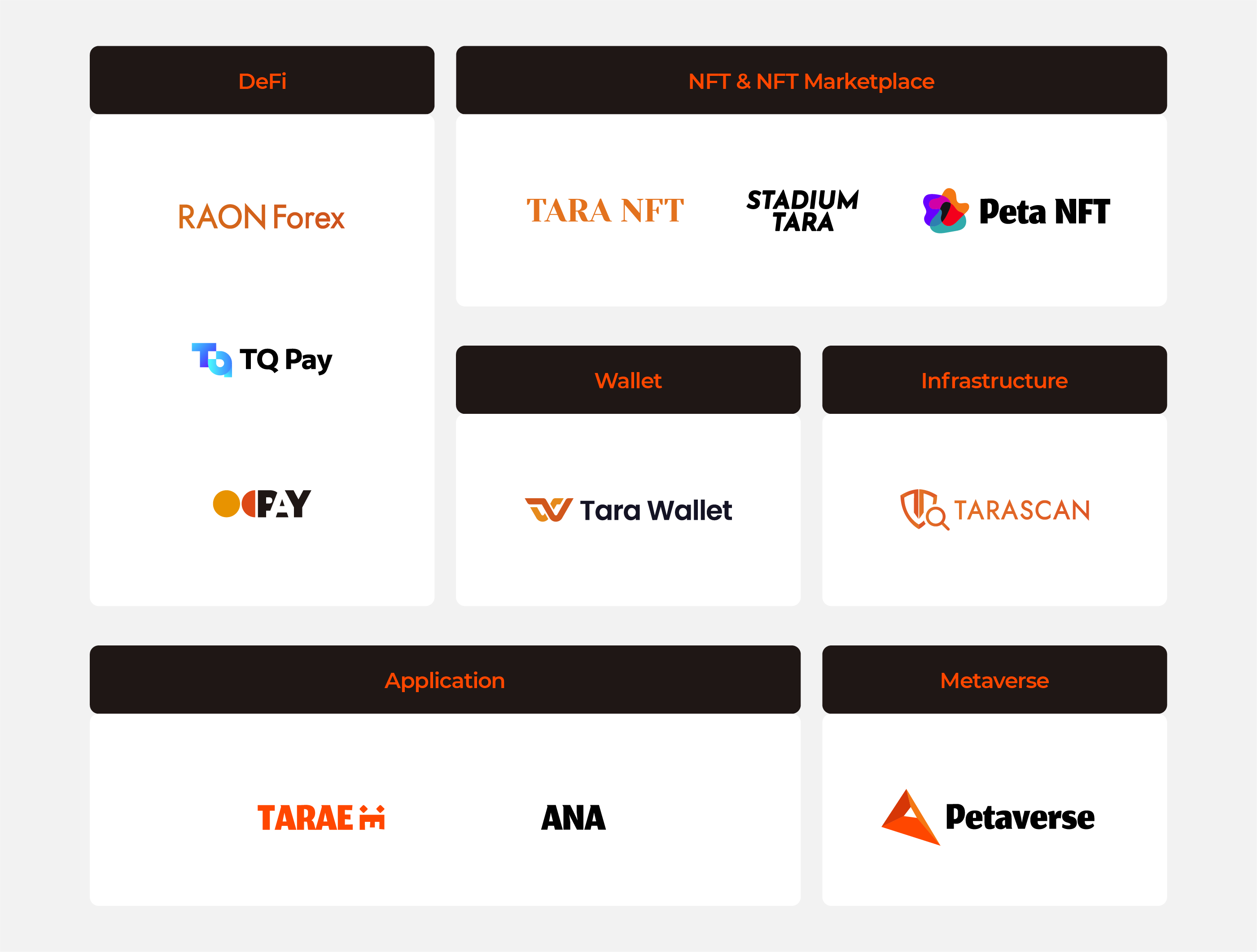
DeFi
RAON Forex
RAON Forex is a global decentralized exchange on the TARA CHAIN mainnet.
Raon Forex uses AMM (Automatic Market Maker), and the exchange supports a total of four functions: swap, liquidity pool deposit, staking, and drop. When a project collaborating with TARA CHAIN is newly launched, we provide a priority listing service through screening.
TQ PAY
TQ PAY is equipped with the basic functions of electronic financial services such as remittance, transfer, payment, and deposit, which are the basics of the pay system. We plan to develop this model into a next-generation exchange model through service model that exchanges coins for points and points for coins through linking with RAON Forex.
Dot PAY
Dot PAY is a simple payment pay service based on the TARA CHAIN mainnet. It is designed to not only provide basic pay services but also use TARA CHAIN's expanded functions such as NFT member authentication by installing TARA CHAIN Wallet.
Users can use not only the convenience of simple payment services, but also additional functions of blockchain such as NFT membership, NFT pass, and DID identity verification all at once.
Wallet
TARA Wallet
TARA CHAIN-based digital asset wallet ‘TARA Wallet’ is a wallet service optimized for TARA CHAIN. You can use various services more easily and safely, such as storage, transfer, and management of TARA CHAIN-based tokens. ‘TARA Wallet’ users can not only collect and trade NFTs at TARA NFT, but also link and use their wallets with various DeFi DApps.
NFT·NFT Marketplace
TARA NFT
This is an ‘NFT Marketplace’ service that displays and distributes digital works issued as NFTs based on Tarachain. In TARA NFT, users can freely create NFTs, mint them, and freely buy and sell NFTs with other users. Additionally, because it has a platform structure, it can be used as a marketplace for your own projects.
TARA Stadium
TARA Stadium is a TARA CHAIN-based ‘digital sports card’ project platform. In each field, we create projects that allow athletes to make profits using their name, image, and likeness (NIL), and It is a project platform that supports creating and minting NFTs with not only simple images but also plays of popular stars or great scenes.
Peta NFT
‘Peta NFT’ is the starting point of TARA CHAIN’s largest project. This project, which extends from Peta NFT to Metaverse, will provide users with new experiences and emotions they have never experienced before.
Infrastructure
TARA Scan
TARA Scan is a block explorer for the TARA CHAIN network that provides users with network status monitoring functions, transaction data, and various statistics. It provides similar functions to Ethereum's Etherscan, so experienced users can easily check the on-chain records of TARA and TARA CHAIN tokens.
Application
TARAE
TARAE is a TARA CHAIN-based NFT SNS service. It has a two-way sharing function through individual users' profiles, creative content, etc. Registered creative content is created as NFT and can be freely bought and sold.
ANA
ANA (Art NFT Authentication) is a service that is based on TARA CHAIN and linked to NFC to authenticate the authenticity of an art work and to verify authenticity and matching of the appraisal certificate by linking it with the appraisal certificate.
Metaverse
Petaverse
Petaverse is a metaverse project run by TARA CHAIN. The Petaverse project, which follows Peta NFT, will provide users with new experiences and emotions they have never experienced before.
transaction fee burn
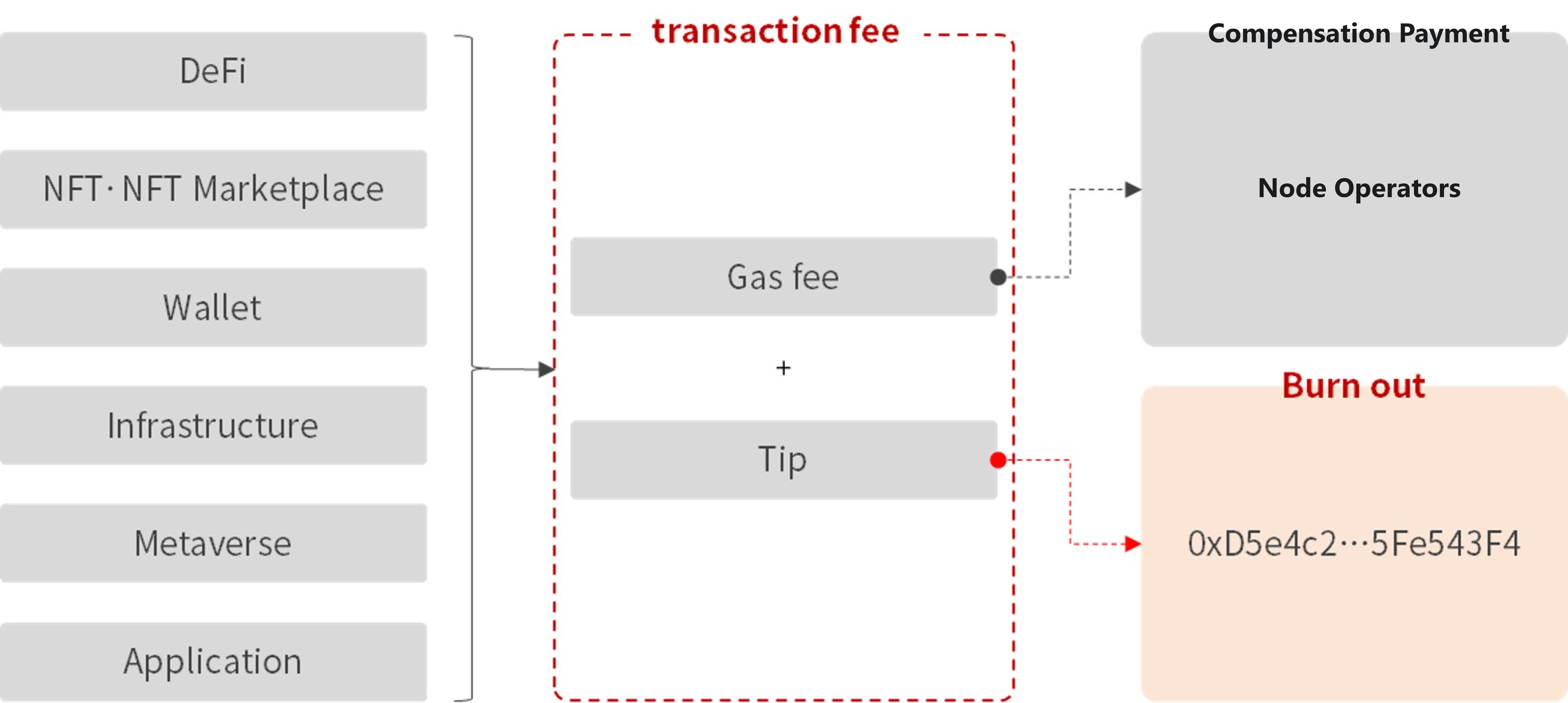
Token burning means removing a portion of tokens in circulation based on the basic economic principles of supply and demand. TARA CHAIN makes tokens scarce and increases the value of cryptocurrency by reducing the number of tokens in circulation.
TARA CHAIN's incineration involves paying an operation compensation (gas fee) to the node operator (miner or block producer) and incinerating all remaining tips, thereby distributing profits evenly and effectively operating deflation mechanism without causing direct damage to investors.
Conclusion
Conclusion
TARA CHAIN's vision began with the purpose of commercializing blockchain by applying it to the real economy, but is based on a 'scientific dream' that the world can be changed by communication with computers, thanks to the high-speed network expansion policy which is implementing to allow anyone to easily access the Internet. To achieve this vision, we have directly implemented and designed the underlying protocol architecture as well as core services.
TARA CHAIN is constantly researching and developing and providing new ideas to the ecosystem to improve scalability, security, or sustainability of the ecosystem, and continues to grow and expand like the natural ecosystem around us.
Just as we start with a single tree and expand into a forest, we hope that a new ecosystem will be created locally within the ecosystem called TARA CHAIN, and that all the created ecosystems will organically interconnect and expand.
We want to present a branch of the new paradigm of the digital age from a connection between reality and virtuality, real life and humanities perspectives.
And, we hope that the world will develop in a better direction through communication through networks within this huge ecosystem.





